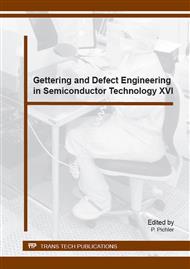[1]
G.H. Schwuttke, K. Brack, E.F. Gorey, Radiation Effects 6 (1970) 103–106.
Google Scholar
[2]
R. Job, J.G. Laven, F. -J. Niedernostheide, H. -J. Schulze, H. Schulze, W. Schustereder, Phys. Status Solidi A 209 (2012) 1940–(1949).
DOI: 10.1002/pssa.201200151
Google Scholar
[3]
J. Hartung, J. Weber, Materials Science and Engineering B 4 (1989) 47–50.
Google Scholar
[4]
Y. Zohta, Y. Ohmura, M. Kanazawa, Jpn. J. Appl. Phys. 10 (1971) 532–533.
Google Scholar
[5]
Y. Ohmura, Y. Zohta, M. Kanazawa, Phys. Stat. Sol. (a) 15 (1973) 93–98.
Google Scholar
[6]
Y.V. Gorelkinskii, V.O. Sigle, Z.S. Takibaev, Phys. Stat. Sol. (a) 22 (1974) K55-K57.
DOI: 10.1002/pssa.2210220156
Google Scholar
[7]
A.T. Isova, V.V. Klimenov, I.S. Nevmerzhitsky, M.A. Zakharov, M.A. Yeleuov, S.Z. Tokmoldin, Physica B: Condensed Matter 404 (2009) 5089–5092.
DOI: 10.1016/j.physb.2009.08.229
Google Scholar
[8]
S. Tokmoldin, A.T. Issova, K. Abdullin, B.N. Mukashev, Physica B: Condensed Matter 376-377 (2006) 185–188.
DOI: 10.1016/j.physb.2005.12.049
Google Scholar
[9]
W. Wondrak, D. Silber, Physica B+C 129 (1985) 322–326.
Google Scholar
[10]
S. Selberherr, P. Pichler, Intrinsic Point Defects, Impurities, and Their Diffusion in Silicon, Springer Vienna, Vienna, (2004).
Google Scholar
[11]
S.K. Estreicher, J.L. Hastings, Appl. Phys. Lett. 70 (1997) 432–434.
Google Scholar
[12]
E.V. Monakhov, B.S. Avset, A. Hallén, B.G. Svensson, Phys. Rev. B 65 (2002).
Google Scholar
[13]
M. Jelinek, J.G. Laven, M. Rommel, W. Schustereder, H. -J. Schulze, L. Frey, R. Job, ECS Transactions 64 (2014) 173–185.
DOI: 10.1149/06411.0173ecst
Google Scholar
[14]
K. Irmscher, H. Klose, K. Maass, J. Phys. C: Solid State Phys. 17 (1984) 6317–6329.
DOI: 10.1088/0022-3719/17/35/007
Google Scholar
[15]
M.W. Hüppi, Materials Science and Engineering: B 2 (1989) 87–90.
Google Scholar
[16]
J.G. Laven, M. Jelinek, R. Job, W. Schustereder, H. -J. Schulze, M. Rommel, L. Frey, Phys. Status Solidi B 251 (2014) 2189–2192.
DOI: 10.1002/pssb.201400028
Google Scholar
[17]
N. Ganagona, B. Raeissi, L. Vines, E.V. Monakhov, B.G. Svensson, Phys. Status Solidi C 9 (2012) 2009–(2012).
DOI: 10.1002/pssc.201200217
Google Scholar
[18]
S. Weiss, R. Kassing, Solid-State Electronics 31 (1988) 1733–1742.
Google Scholar
[19]
J.F. Ziegler, M.D. Ziegler, J.P. Biersack, Nuclear Instruments and Methods in Physics Research Section B: Beam Interactions with Materials and Atoms 268 (2010) 1818–1823.
DOI: 10.1016/j.nimb.2010.02.091
Google Scholar
[20]
D.V. Lang, J. Appl. Phys. 45 (1974) 3023.
Google Scholar
[21]
J.G. Laven, Protonendotierung von Silizium: Untersuchung und Modellierung protoneninduzierter Dotierungsprofile in Silizium. Univ. Diss., Erlangen-Nürnberg, 2013, Springer Vieweg, Wiesbaden, (2014).
DOI: 10.1007/978-3-658-07390-9
Google Scholar
[22]
E. Simoen, C. Claeys, J.M. Rafí, A.G. Ulyashin, Materials Science and Engineering: B 134 (2006) 189–192.
DOI: 10.1016/j.mseb.2006.06.041
Google Scholar
[23]
K.L. Wang, Y.H. Lee, J.W. Corbett, Appl. Phys. Lett. 33 (1978) 547.
Google Scholar
[24]
J.W. Walker, C.T. Sah, Phys. Rev. B 7 (1973) 4587–4605.
Google Scholar
[25]
G.D. Watkins, J.W. Corbett, Phys. Rev. 138 (1965) A543-A555.
Google Scholar


